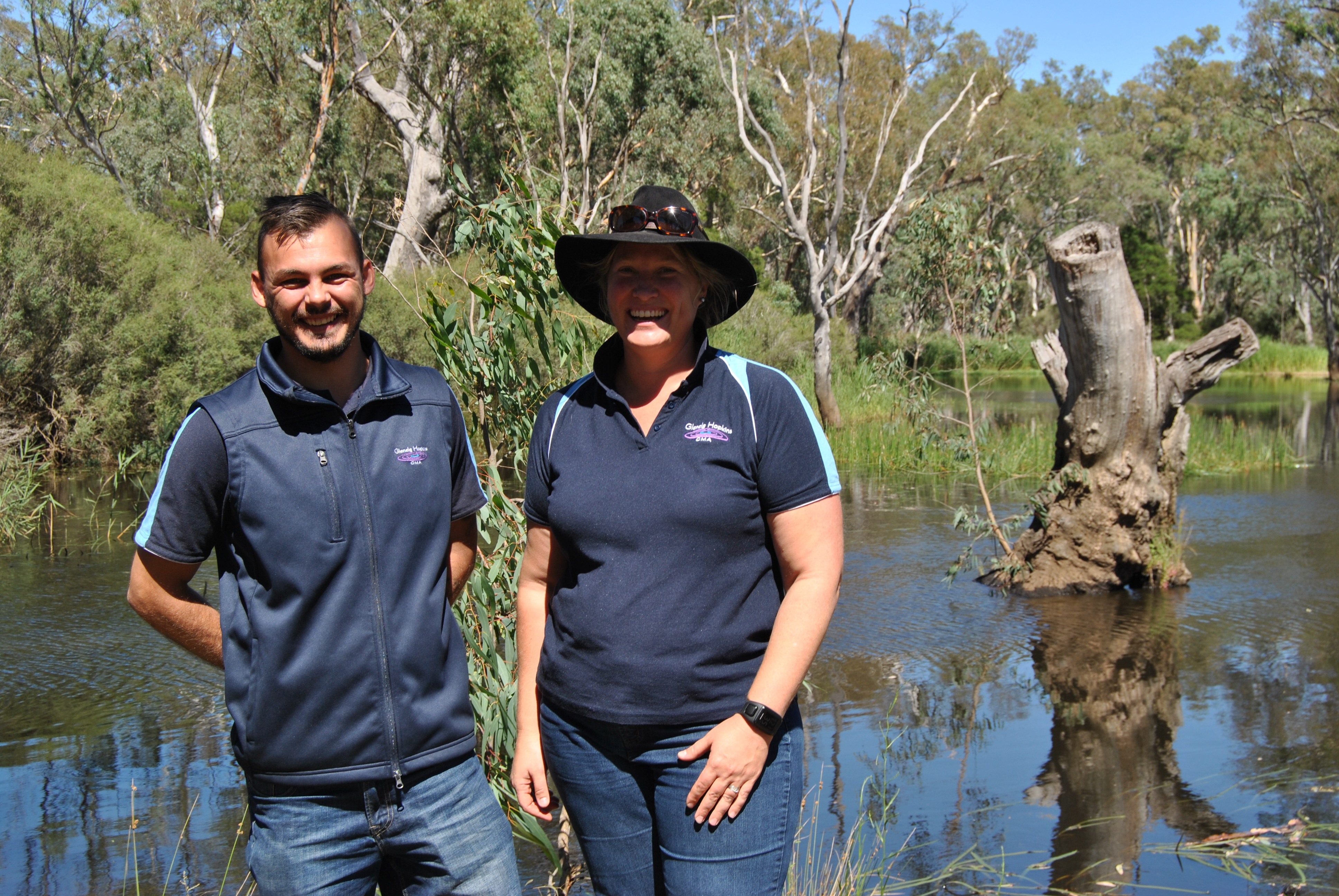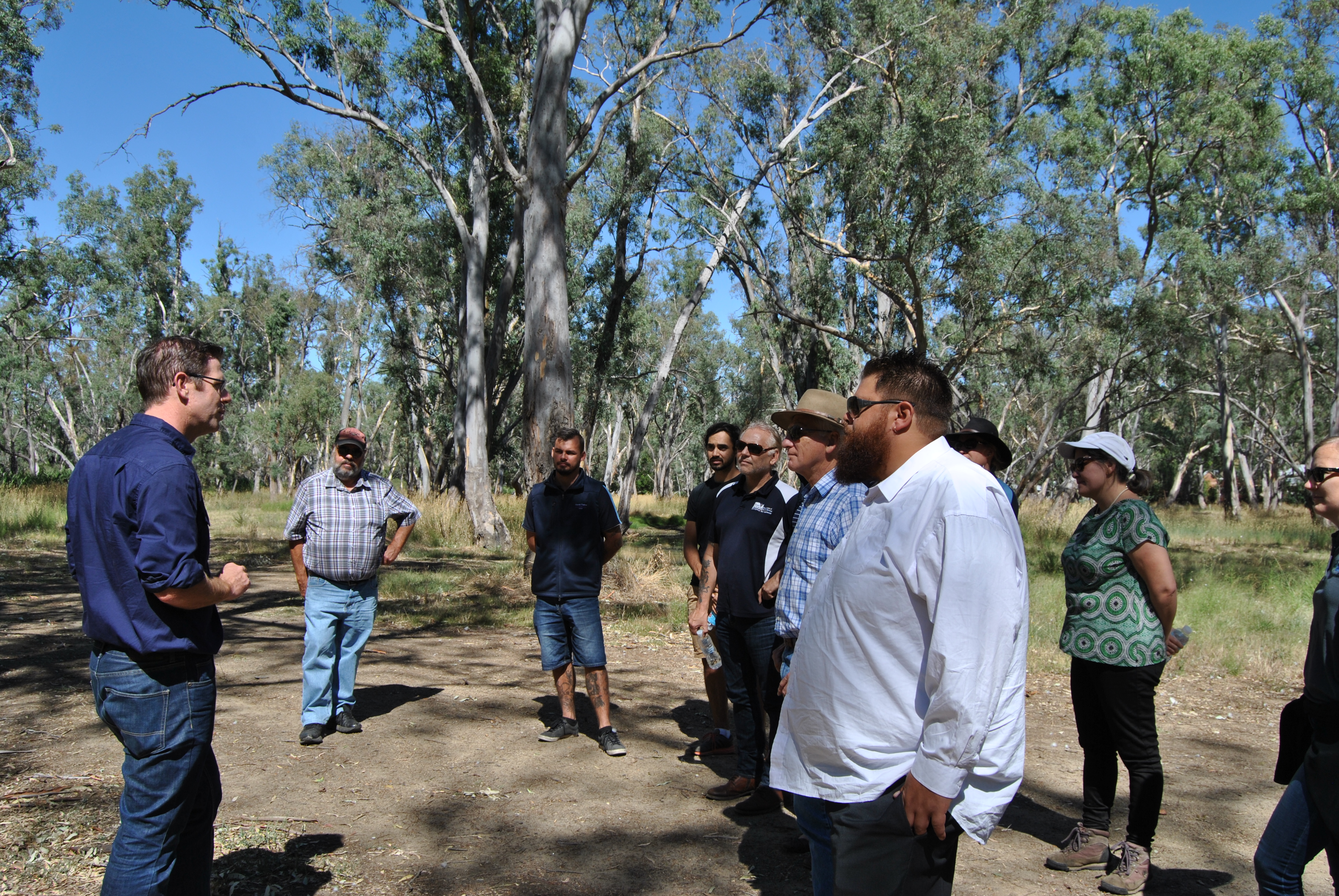Victoria's river systems flow through landscapes which are culturally significant to Traditional Owner groups, whose ancestors have lived along these rivers for tens of thousands of years.
In 2016–17, two projects in western Victoria provided the opportunity for Traditional Owners to reconnect with the Glenelg and Wimmera rivers and to talk with water managers about their aspirations for how water is managed along the rivers.
The Traditional Owners were represented by the Gunditj Mirring Traditional Owner Aboriginal Corporation and the Barengi Gadjin Land Council.
The Towards Cultural Flows project focuses on the Glenelg River and is a partnership between the Glenelg Hopkins CMA, Gunditj Mirring and Barengi Gadjin, while the River Yarns project focuses on the Wimmera River and is a partnership between the Wimmera CMA and Barengi Gadjin.
Glenelg Hopkins CMA staff Ryan Jones and Jane Walker by the Glenelg River working on the Towards Cultural Flows project, by Glenelg Hopkins CMA
Benefits for Aboriginal people from environmental flows
Both projects are seeking to find out more about the story places and plant and animal species along the rivers that are significant for Traditional Owners, so these values can be supported using environmental flows.
Glenelg Hopkins CMA Project Officer Jane Walker said this information will be incorporated into environmental watering plans for the Glenelg River in future.
"The purpose of the Towards Cultural Flows project is to see what is significant about the river system for Traditional Owners and to look at where the CMA can potentially support their interests in the Glenelg River through environmental flows," Jane said.
In March 2017, the Glenelg Hopkins CMA did just that. In a first for Victoria, the timing of an environmental flow was tweaked to support environmental outcomes as well as Aboriginal values along the Glenelg River.
Each year, a team of Aboriginal cricketers and a local cricket team vie for the Johnny Mullagh Memorial Cup, an annual event that celebrates the first Australian Test team. The team toured England in 1868 and was made up of Aboriginal men from the
Harrow area, one of whom was Mullagh, who continued to play Test cricket. Water was released from Rocklands Reservoir between 21 February and 1 March to coincide with the cup match on the March long weekend at Harrow. People at the match enjoyed more flow in the river, better quality water for swimming and a pleasant place to camp and play.
As well as freshening the water for native plants and animals and improving the river's useability and amenity for the cricketers, spectators and others, the environmental flows resulted in many other benefits including support for cultural heritage values (such as scarred trees and native plants, which are sources of traditional foods and medicines).
The benefits flow on
Wimmera CMA Aboriginal Water Officer Ben Muir said one of the most significant benefits for Traditional Owners of the River Yarns project was the opportunity to reconnect with many parts of their Country.
"The elders had not been to some of these places for a long time. It was very emotional to go back there," Ben said.
The river trips and community gatherings drew out memories and stories that have not been shared for decades.
Jane Walker said another benefit had been building cross-cultural understanding about the Glenelg and Wimmera rivers.
"Part of the journey is learning about the river system, learning about the knowledge Traditional Owners have about the river and about the history of the river, and combining that with modern management approaches and western science," she said.
A key benefit of both projects has been the opportunity to build relationships that will provide the foundation for longer-term projects. Through Towards Cultural Flows and River Yarns, Gunditj Mirring and Barengi Gadjin have developed relationships with the CMAs as well as with other water and land agencies, other Aboriginal organisations, community groups, ecologists and archaeologists.
"We had fantastic feedback from everyone involved," Wimmera CMA Community Delivery Manager Joel Boyd said.
"It is really just the start of ongoing discussions with the local community to build partnerships and work together to create opportunities."
From little things, big things grow
Stories from the River Yarns project are now being shared at gatherings and through performances, films and an interactive online story map. The Towards Cultural Flows project team have been having similar gatherings to tell their story, and they have
presented their knowledge at conferences.
Gunditj Mirring and Barengi Gadjin hope that projects like these will ensure local Aboriginal values and customary uses are better linked to water planning and river management.
For a long time, Aboriginal groups have been calling for water rights and meaningful participation in water management across Australia. These projects respond to Traditional Owner rights and interests in waterway management and they are generating many opportunities to improve the health of Aboriginal people and Country.
Traditional Owners getting involved in the Towards Cultural Flows project on the Glenelg River, by Glenelg Hopkins CMA

